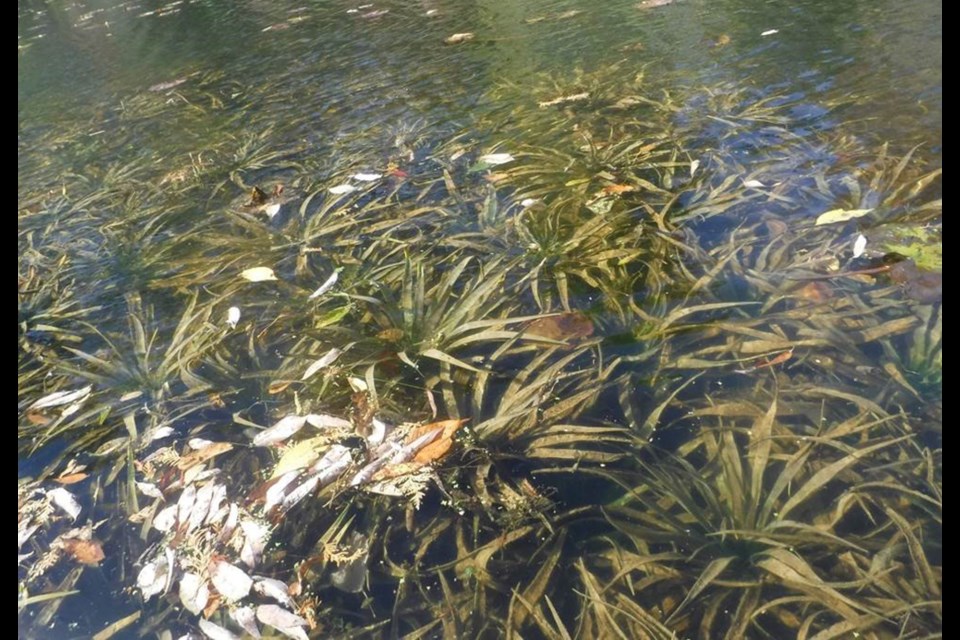Water gardeners take note: Some of those plants that look so attractive in the backyard pond pose a real threat to the environment if they escape into the wild.
Like water soldier. Also known as water aloe or crab’s claws, Stratiotes aloides (the Latin name) is a perennial that grows in rosette form under the water, at a depth of up to five metres. During the summer, it rises to the surface, forming dense floating mats.
Native to Asia, the only place it has become established in North America is in Ontario’s Trent-Severn waterway – but the Ministry of Natural Resources and Forestry (MNRF) and Lake Simcoe Region Conservation Authority recently had a scare, when a “pod” of the plant was found in the Black River in 2015.
Not only can the plant form “enormous” colonies, out-competing native species, it can alter the water chemistry in the areas that it dominates, and inhibit the growth of phytoplankton – the floating tiny plants and animals on which young fish feed.
And the sharp, spiny edges of its sword-like leaves can leave swimmers cut and bleeding.
It’s a disaster in the making for Ontario’s recreational sector, which is why reaction to the Black River infestation was so swift.
The Black River pod consisted of between 300 and 400 plants at three sites – probably originally “escaped” from an ornamental pond, said Wil Wegman, with MNRF’s Aurora branch.
Recognizing the threat to the Lake Simcoe watershed, the ministry worked with local contractor Mike Nealon to design a 122-metre silt barrier, to keep the plants contained while they were removed by ministry staff. Installed at a dam in Sutton, the barrier caught any plants set adrift during the removal effort.
It seems to have worked. Monitoring last year and this year found no water soldier plants in the Black River. “We are hopeful that removal efforts have been successful,” said Wegman. “Fortunately, the species is no longer legal to sell in garden centres in Ontario.”
In 2016, water soldier was declared a “prohibited invasive species” – making it illegal to import, own, deposit, release, transport, breed or grow, buy, sell or trade the plant anywhere in the province.
“The Black River’s a real success story. They hit it hard and fast enough,” said Brian Ginn, Limnologist with the Lake Simcoe Region Conservation Authority.
But it’s a different story in the Trent-Severn, where water soldier was first spotted in 2008. Ginn has a series of photographs, showing one location along the Trent-Severn over three years, 2013-2016.
In the first photograph, isolated spiny water soldier plants can be seen breaking through a mat of native aquatic plants. In year two, the water soldier plants dominate. By year three, the mat of floating water soldier extends far from shore, restricting recreational use of the area; no native plants are visible within the dense growth.
The MNRF has attacked the invader with herbicides. Last year, the plant was mapped along 55 kilometres of the Trent-Severn, and 175 hectares of the invasive plant were treated. Treatment is also scheduled for late this summer or early fall – but it’s an ongoing battle.
Boaters have a key role to play in the fight against water soldier. Wegman called on boaters to practice the ‘Clean, Drain, Dry’ protocol, whenever moving their boats. Clean off all aquatic plants and animals from both boat and trailer; drain all water and empty live-wells; then allow the boat and motor to dry for at least a week, before entering a new water body.
It’s the best way to ensure that invasive species aren’t given new spaces to conquer.
And gardeners are asked to plant native species, avoiding non-native plants that could become invaders.
As the LSRCA noted, “The most effective strategy against invasive species is to prevent them from ever being introduced and established… Once introduced, invasive species can be next to impossible to eliminate.”
Anyone who spots water soldier in the wild should contact the Invading Species Awareness Program, Ontario Invasive Plant Council, or the Early Detection and Distribution Mapping System at here.



